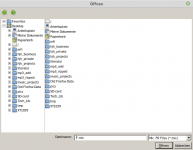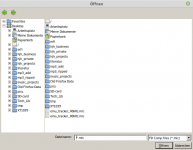yes, the bandwidth is directly related to the sample-rate.Using ARTA for some time now I am curious if it is possible to increase the bandwidth of the spectrum analyzer
to 30 kHZ. Is this possible by simply using a better sound card?
For 30kHz one needs at least 60kHz sample-rate, so in standard audio sample-rate that means you need one with at least 96kHz
Member
Joined 2003
Just adjust the sample rate and have at it. There's no problem running the spectrum analyzer at 96kHz or higher if your audio device supports it. However, I would also run single channel FR1 loopback as well, you will find that most audio devices will roll off the response >20kHz regardless of sample rate, so 192kHz or higher sample rate doesn't actually get you frequency response to 96kHz and beyond.
And a microphone which is linear up to that range. The cheapest I know of is the Earthworks M30.Using ARTA for some time now I am curious if it is possible to increase the bandwidth of the spectrum analyzer
to 30 kHZ. Is this possible by simply using a better sound card?
You can measure with an external stimulus source using the original Farina method and the Aurora plugin. Go for the version bundled with the old edition of Audacity; it's quite easy to use:But my question was whether it could be done with ARTA and if so how, not what other software could I use besides the software I paid for, know and love, and have used for many years for audio measurements. After all this is the ARTA thread I posted in...
As for "MidFi TV outputs" that was just an example. I can think of numerous devices whose DAC and analogue outputs could be measured which do not have analogue inputs to allow real time measurement. So there is a fairly wide use case.
Perhaps it also doesn't occur to you that measuring devices of "unknown" and potentially middling quality level might be why the measurements are being taken in the first place, to establish what their true level of quality is ?
There's no fun in measuring something that measures almost perfect...
http://www.angelofarina.it/Public/Aurora-for-Audacity/2.4.1/
There's a help file and forum here:
http://pcfarina.eng.unipr.it/Aurora/download/Manual-HelpFile/https://aurora-plugins.forumfree.it/
You can then export the deconvolved IR as a WAV, and import it into ARTA to use the tools you're familiar with to analyse the results.
Well I am using the Arta software only to measure THD+N of my amplifier design. So using an external signal source at the inputAnd a microphone which is linear up to that range. The cheapest I know of is the Earthworks M30.
of the amp and connect the amp output right into the left channel of the sound input of my computer.
Then hitting the Arta SPA button for the spectrum analysis (of course taking care the signal output level doesn't exceed the allowed value of the sound card).
There is only the chain: signal generator > Amp under test > Sound card > Arta.That’s fine, so long as you’re aware of the nonlinear behaviours of your measurement setup when analysing the results of the combined transfer functions.
So relatively easy to detect non linear behaviours. Or do I overlook something?
Does anyone know of an Arta test box that will operate with a power amp that has a non-grounded differential output like a chip amp? I did a schematic for a design with differential amplifiers but I would prefer to buy something rather than build if possible.
At this moment there is not.
(yet, I am working on it, but chip shortages delayed that plan a little...)
I have a PCB for an engineering model on the way from OSH Park. Designed to operate with a bridged amplifier, it uses a couple of Linear Tech LT1167s to provide differential reference and measured voltages.
I usually measure dist
Think the LT1167 are a little overkill/excessive to use hereI have a PCB for an engineering model on the way from OSH Park. Designed to operate with a bridged amplifier, it uses a couple of Linear Tech LT1167s to provide differential reference and measured voltages.
My soundinterface provides a symmetrical input. So all I had to do built a 2-channel resistor attenuator. You may start with an attenuation of 30dB.I have a PCB for an engineering model on the way from OSH Park. Designed to operate with a bridged amplifier, it uses a couple of Linear Tech LT1167s to provide differential reference and measured voltages.
Good point. I have a Focusrite Scarlett 2i4 with two XLR inputs. The max input level when set to line input is +26 dBu.My soundinterface provides a symmetrical input. So all I had to do built a 2-channel resistor attenuator. You may start with an attenuation of 30dB.
+1I am badly missing a way to measure THD+N within STEPS/record/Distortion vs amplitude.
Any ideas?
30dB attenuation is probably a bit much.My soundinterface provides a symmetrical input. So all I had to do built a 2-channel resistor attenuator. You may start with an attenuation of 30dB.
Most XLR input interfaces can handle 7-10Vrms. Some even more.
Most also have an attenuation switch as well.
The relative error is quite a bit bigger compared to a single ended amplifier.
So it can be a bit fiddly to calibrate those things out.
My soundinterface is a simple EMU-Tracker pre with max 3Vrms input. THD sweetspot about 0.5Vrms.30dB attenuation is probably a bit much.
Most XLR input interfaces can handle 7-10Vrms. Some even more.
Most also have an attenuation switch as well.
The relative error is quite a bit bigger compared to a single ended amplifier.
So it can be a bit fiddly to calibrate those things out.
Using ARTA instead this works flawlessly! I guess this may be a bug inside STEPS?I just struggled loading a *.mic file into STEPs. Mic files are simply not found
Attachments
Member
Joined 2003
Member
Joined 2003
As a feature request, I'd love to be able to set multiple markers in ARTA's spectrum analyzer to use it more like a real spectrum analyzer. For example measuring distortion products of 1kHz sine, it would be great to set markers at 2kHz, 3kHz, 4kHz etc and monitor the harmonic amplitude directly. As it is ARTA SPA will only show THD as a calculated result, and of course there would be many other uses to be able to set frequency monitoring markers

